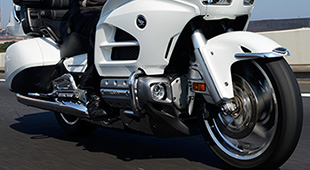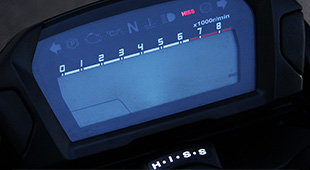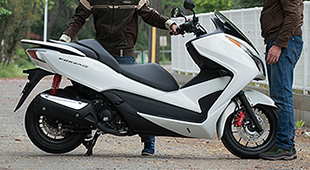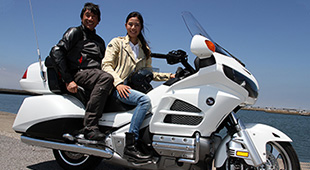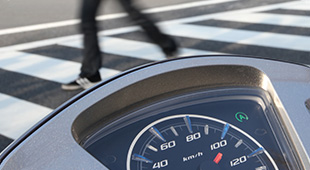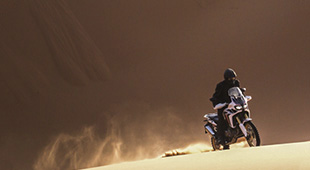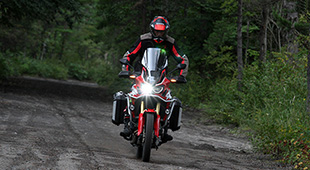Tech Views — Vol. 9 G Switch and Selectable Torque Control
Impressions (1/3)
What I tried on the test course and what became clear
As advised by the development team, I first attempted to check the various G Switch settings on a paved road surface. As for whether the objective differences were clearly evident or not…. please watch the following video:
With the G Switch in Its Default Position (OFF):
For this test, I set the DCT to MT (Manual) mode and selected first gear, which is where any differences would be easiest to detect. The test was conducted by keeping my speed at a constant 20km/h and repeatedly opening and closing the throttle from that speed to check its feel during acceleration and deceleration.
First I checked how it felt with the G Switch OFF. Opening the throttle, the bike accelerated smoothly without any particularly abrupt movements. Similarly, when I closed the throttle, the bike slowed smoothly. As speed increased a bit, the feeling of ‘directness’ in the bike’s response to my throttle inputs seemed to increase, and as engine revs increased, the sensation of speed increased accordingly. When I closed the throttle, the effect of engine braking got stronger. Only moderate changes in attitude were detectable at the instant the throttle was opened to accelerate or closed for engine braking.
With the G Switch ON:
Next, I conducted a similar test with the G Switch switched ON. The feeling of drive impact that could be felt when the throttle was opened or closed was clearly different. It gave the impression that the rear wheel’s drive was instantly responding to throttle operation, making it feel as if the throttle and the rear wheel were directly connected to each other. It was more like a standard MT (Manual Transmission) model, although that might be a bit of an exaggeration. I was thus able to confirm the development team’s objectives in developing the G Switch.
Testing the G Switch in Figure 8 Turns on an Off-Road Course
Next, I conducted some tests on the flat part of an off-road course to check the difference felt with the G Switch ON and OFF. In this test I rode the bike in a figure eight pattern, which the development engineers told me was the best way to understand the bike’s movement when the throttle is opened and closed, and to more easily get a feel for the G Switch’s effectiveness.
My figure eights were run around two road cones set down at an appropriate distance from each other. Here various operations and maneuvers, such as acceleration, deceleration and turning, followed by acceleration again, could take place in a short period of time. The development team suggested that I check the G Switch’s characteristics based on these changes. Moreover, I’d be doing four tests, comparing the feel with the G Switch OFF and ON and the Selectable Torque Control set to its default value (Level 3), and then again with the Selectable Torque Control switched OFF. I did three laps in each test, which took me less than a minute. Since my body would gradually adapt as I got used to the test, I tried to focus my efforts on simply comparing the differences I felt based on my first impressions of the G Switch being switched ON and OFF.
Testing was conducted under the following conditions:
DCT operating mode: D (Drive)
Front and rear tires: OEM
Tire air pressure: standard
Figure-Eight Turns — Test 1
Selectable Torque Control: Default (Level 3)
G Switch: Default (OFF)
Lap 1: Starting from the straight line portion of my ‘course’ and turning counterclockwise around the first cone, I closed the throttle and used engine braking to begin my lean into the turn. At that instant, it felt like the Africa Twin was floating a bit. I wanted to lean the bike enough for a front wheel turn angle that would be just inside the limits of front tire grip on the dirt road surface. I was a bit concerned, however, because this maneuver had to be done cold, without practice. I started the bike out by opening the throttle and increasing my speed toward the other cone. The instant the throttle opened, the bike slowly launched into motion as the Selectable Torque Control began its intervention.
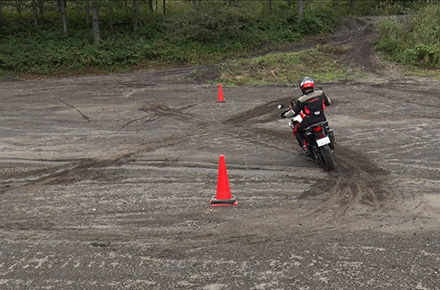
Lap 2: As my speed increased linearly, I closed the throttle to slow down. Like on Lap 1, at that instant I felt a small interval where the drive seemed to be intermittent due to the DCT’s operation, which seemed to soften the shock of sudden deceleration, and it felt like the bike was making a larger turn as I leaned. This impression remained through Lap 3.
Figure-Eight Turns — Test 2
Selectable Torque Control: Default (Level 3)
G Switch: ON
As with Test 1, I entered my figure eight course from the straight line, closing the throttle to decelerate as I approached the first pylon. At that moment, it felt like the G Switch must be on, as the feeling that the rear wheel was more firmly gripping the road surface with the engine braking was clearly being transmitted to me. I felt as if I was able to lean the bike more and enter the turn with more confidence than in Test 1.
Next, I increased straight line speed, closed the throttle, reduced speed and leaned the bike. Here, too, this series of operations seemed to be more smoothly connected. There wasn’t quite the feeling of gently floating that I’d experienced in Test 1, and since the Africa Twin could be leaned quickly and more deeply, the lean angle balanced well with the front wheel’s steering angle and the front suspension seemed to be doing its job well. I didn’t have the feeling that I was meekly trying to lean the bike that I’d experienced in Test 1. When accelerating after the turn, the Selectable Torque Control intervened the instant the throttle opened, at the start of acceleration. In other words, the feeling of kick at the rear wheel was stronger with the G Switch ON.
This really helped me understand the effect of the G Switch. I had the same impression on my third lap as well. Was it because I’d grown more accustomed to the test, or was it because it was actually easier to run the course than in Test 1? I was still unsure of my feelings.
What I was really feeling in Test 2 was, if anything, more of a sensation of grip between the rear wheel and the road surface when I closed the throttle.
Figure-Eight Turns — Test 3
Selectable Torque Control: OFF
G Switch: Default (OFF)
This test confirmed that what I’d experienced so far was not a figment of my imagination.
Entering the course from the straight line, I closed the throttle to slow down for the first turn. While it felt about as easy to lean as in Test 1, it clearly couldn’t be leaned as far as I’d experienced in Test 2. It felt like there was a slight lag, causing a subsequent slight delay in the leaning of the bike. As a result, the front wheel made a bit of a roundabout turn outside my ideal line. Next, I shifted to straight line acceleration, standing up the bike after opening the throttle. However, this time too, because my turn line was wide, the bike seemed to gobble up the straight, making it feel as if my acceleration distance had suddenly gotten shorter. If I compensated for this deficiency by opening the throttle more, the force of acceleration would cause the rear wheel to slide and the bike’s rear end to fishtail out.
Also, during the process of closing the throttle and slowing down, a phenomenon similar to that of my first turn in Lap 1 occurred, making me feel like I was running wide:
Bike lean entering the turn delayed. →
Acceleration out of turn also slightly delayed. →
More throttle on straight to recover. →
Rear end starts to slide sideways →
Deceleration delayed.
— The more laps I rode, the more irritated I became with my riding.
Figure-Eight Turns — Test 4
Selectable Torque Control: OFF
G Switch: ON
One result of turning OFF the Selectable Torque Control in Test 3 was that I started experiencing power slides. Thinking back, in the process of closing the throttle to decelerate from the straight line and leaning the bike to set up for the turn, the momentary delay in throttle response also delayed the turn. I thought through this phenomenon and concentrated on staying on my ideal line.
Approaching the cone from the straight line, I closed the throttle to reduce speed. As expected from my experience in Test 2, the effects of turning ON the G Switch could be felt the instant I closed the throttle. The feeling of deceleration as engine braking was applied directly to the rear wheel was greatly increased in addition to my actual braking. Also, this may easily center on the moment of leaning the bike into my turning line and the subsequent series of actions related to leaning and turning was again smoothly connected.
Since the Africa Twin turns easily in small circles, the impression was that while I could open the throttle to raise the bike — and the bike did stand upright as desired — it also increased straight line speed, suppressing tailslides even while accelerating in the straight line area. The force of acceleration was not wasted veering off in the horizontal direction. This change in the Africa Twin’s behavior occurred as a result of having turned on the G Switch rather than as a benefit of the G Switch. When the throttle opened, control during acceleration was, of course, easier to manage.
I experienced the same favorable results on my second and third laps, and my immediate reaction was “Well done!” as I managed to ride skillfully and successfully, and not feel, “Oops, I was too slow making that maneuver and got off my line…” I was feeling pretty good at this point.
In conclusion, turning ON the G Switch on a slippery road surface, regardless of whether the throttle is open or closed, really helps to make the bike more controllable, even as I continued to do some really extreme figure eight riding. The irritation I felt in Test 3 because my turns were late had virtually disappeared, and the G Switch seemed to perfectly tune my riding, figure eight riding and the Africa Twin’s operation.
After completing the test, I checked my results with Mr. Ito, one of the development engineers. He thought that I might be feeling the benefits of the change in clutch control as the G Switch was turned ON and OFF for throttle operation. One could say that my speed was usually low during the figure eight turns, and the clutch control time didn’t really differ very much whether the G Switch is ON or OFF, so it must have truly been a benefit of the G Switch. Indeed, the G Switch proved to be really effective when riding off-road.

